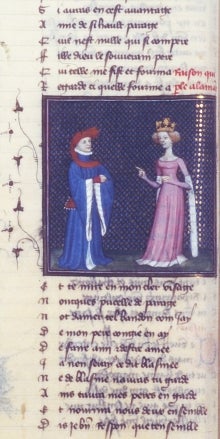La Faculté des Lettres
PAS building room 2401
Read in English
 Detailed Manuscript Information (based on Ernest Langlois, Les manuscrits du Roman de la rose. Description et classement, Geneva: Slatkine Reprints, 1974, p. 48-49):
Detailed Manuscript Information (based on Ernest Langlois, Les manuscrits du Roman de la rose. Description et classement, Geneva: Slatkine Reprints, 1974, p. 48-49):
Parchment, measure: 325 x 231mm, 200 fols numbered by a rubricator, at two columns, 37 lines. Beginning of second folio: D'un aiguillier mignot et gent. Binding with Napoleon's coat of arms. The Roman appears on fols 1-157r, followed by the Testament on fols 158r-167v. Fol. 168 is left blank followed by the Sept articles de la foi on fols 169r-200r and the Codicille on fol. 200r-v.
Scène illustrée
Dame Raison s'offre à Amant.
Dimensions:
Miniature de la largeur d’une colonne
Hauteur: 12 vers
Matériaux et couleurs:
Parchemin
Bleu, rouge, blanc, rose, vert, feuille d’or
Rubrique:
Rubrique, au côté droit, au-dessus de la miniature: “Raison qui p[ar]le a lama[n]s”
Encadrement:
Bordure extérieure dorée, avec barres rouges et blanches à l’intérieur. Vrilles foliées avec feuilles d’or, s’étendant au-delà du côté gauche du cadre.
Fond:
Motif en continu: Grille diagonale. Losanges bleus et dorés, en alternance. Terrain vert, simulé.
Similitudes avec les autres images du corpus:
Les gestes de Dame Raison sont conformes à ceux dépeints dans toutes les trois miniatures du manuscrit BNF, Ms. Fr. 12595 et aux gestes dépeints dans PML, Ms. M. 324, ÖNB, Codex 2592, BMC, Ms. 207, KBR, Ms. 4782.
Sources secondaires:
Fleming, John V. The Roman de la Rose: A Study in Allegory and Iconography. Princeton: Princeton UP, 1969.
Lady Reason is typically thought of as a queen, represented with a crown and standing by or descending from her tower, a symbol of her exalted station and a reminder that she descends to aid man. Sometimes wears the scarf of 14thcentury Gothic Virgins (Fleming 113).
Reason shares the iconographical attributes of Lady Philosophy, kinship with Divine Sapience, or the Second Person of the Trinity in both Guillaume and Jean (Fleming 114).
Allégories:
Dame Raison à la droite
Amant à la gauche
Vêtements:
1. Amant
Houppelande bleue, garnie en blanc
Chaperon rouge
Ceinture noire
Gibecière rouge
Bombards rouges
2. Dame Raison
Longue robe rose avec étoles blanches
Vasquine blanche
Couronne d’or sur la tête
Gestes:
L’index de Dame Raison est élevé en signe de parole, signifiant son rôle d’enseignante.
L’Amant a les bras croisés sur la pointrine, signifiant son rôle d’auditeur.
![]() © Bibliothèque nationale de France
© Bibliothèque nationale de France
This work is licensed under a Creative Commons Licence © 2012
La Faculté des Lettres
PAS building room 2401
The University of Waterloo acknowledges that much of our work takes place on the traditional territory of the Neutral, Anishinaabeg, and Haudenosaunee peoples. Our main campus is situated on the Haldimand Tract, the land granted to the Six Nations that includes six miles on each side of the Grand River. Our active work toward reconciliation takes place across our campuses through research, learning, teaching, and community building, and is co-ordinated within the Office of Indigenous Relations.